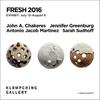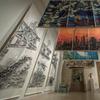Detroit Institute of Arts Exhibition Shows How Hot Beverages Disrupted 16th-Century Europe
- DETROIT, Michigan
- /
- November 21, 2016
The Detroit Institute of Arts (DIA) presents “Bitter|Sweet: Coffee, Tea & Chocolate,” on view Nov. 20, 2016–March 5, 2017. The introduction of coffee, tea and chocolate to Europe, beginning in the late 16th century, profoundly changed drinking habits, tastes and social customs, and spurred an insatiable demand for specialized vessels such as tea canisters, coffee cups, sugar bowls and chocolate pots. The exhibition is organized by the Detroit Institute of Arts with support from the National Endowment for the Arts.
The 68 works of art in “Bitter|Sweet” are mostly from the museum’s comprehensive holdings in pre-1850 European silver and ceramics. Highlights include three exquisitely decorated beverage services: a rare 24-piece set made by Germany’s Fürstenberg Porcelain Manufactory; a set once owned by Prince Louis, Duke of Nemours that illustrates the refinement of early 19th-century French Sèvres porcelain; and a Vienna Porcelain ensemble for two associated with Archduke Joseph of Austria. DIA paintings, prints and sculpture related to the arrival and impact of the beverages in Europe help create new contexts and connections for objects from the permanent collection.
Other key works include Madame de Pompadour’s coffee grinder from Paris’ Musée du Louvre, a 1684 handwritten Spanish manuscript satirizing the vogue for chocolate from the Hispanic Society, New York, and an 18th-century German breakfast set containing chocolate beakers from the Clark Art Institute, Williamstown, Massachusetts. Diego Velázquez’s painting “Infanta Maria Theresa” from the Museum of Fine Arts Boston helps tell the story of the cocoa bean’s migration from the New World to the French royal court of Louis XIV via Spain.
“Bitter|Sweet” will be the first DIA exhibition to engage all five senses. In addition to the artworks, there will be videos about the preparation of coffee, tea, and chocolate as well as opportunities to touch, to hear, to smell and even to taste. Such interactive components demonstrate the DIA’s commitment to engaging visitors in meaningful experiences with art.
“The exhibition is a very exciting venture for the DIA, with regards to the rich, complex story we’re telling, and the innovative visitor-centered ways in which we are presenting it,” said Salvador Salort-Pons, DIA director. “While European art will be at center stage, the exhibition examines global interconnections from centuries ago that we hope will resonate with all visitors today. Just about everyone, regardless of culture or background, has a personal relationship with one or more of these beverages. I’m also excited about the ways the exhibition engages the permanent collection. Of course, I love that several of the loans in “Bitter|Sweet” comment on Spain’s relationship to chocolate.”
“Bitter|Sweet” also touches on the human cost of procuring the raw materials to produce coffee, tea and chocolate as well as the sugar used to alter the beverages’ bitter taste. Coffee was imported from Africa through the Middle East, tea from Asia, chocolate from the Americas, and sugar harvested by slaves on colonial plantations. To meet demand and keep prices down for the European market, merchants, such as the Dutch East India Company and the British East India Company, eventually found ways to cultivate tea and coffee bushes on foreign lands colonized under their rule.
The catalogue “Coffee, Tea, and Chocolate: Consuming the World" by exhibition curator Yao-Fen You, with essays by Mimi Hellman and Hope Saska, will be available for $25. Distributed by Yale University Press, the elegantly designed book with new photography of DIA artworks demonstrates how the objects associated with coffee, tea and chocolate can eloquently evoke the cultures of these new beverages and the material pleasures that surrounded them.
















